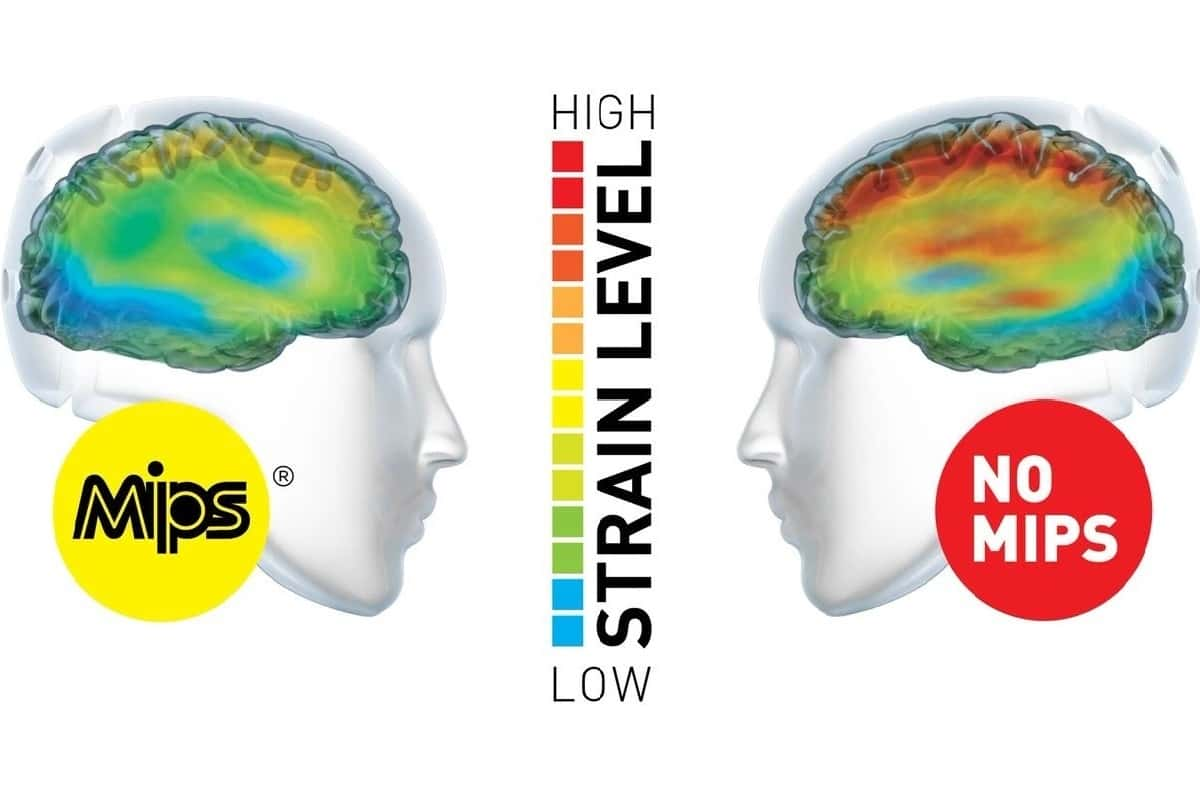MIPS Helmet Technology
MIPS-equipped helmets have been around for a few years now and have become popular with professional cyclists, recreational riders, skiers and snowboarders, horse riders, and even motorcyclists.
Although most of us have seen or heard of MIPS, many people don’t really understand much about it.
Let’s take a look at what MIPS is and what it isn’t, and see if we can clear up any misconceptions about MIPS in helmets.
Page Content

Disclosure: As an Amazon Associate, we earn from qualifying purchases. Disclosure Statement.
What Is MIPS Helmet Technology?
What does MIPS stand for?
MIPS is an acronym for Multi-directional Impact Protection System which is a helmet safety technology that was originally conceived in 1995 in Sweden. Nowadays, you can find MIPS helmet technology in many different types of sporting and recreational helmets.
MIPS helmet technology is simply a thin, yellow polycarbonate liner called a slip-plane inside a helmet. If a helmet wearer is involved in an accident, the slip-plane will rotate slightly inside the helmet during impact to absorb or displace energy from the impact.
This rotation absorbs energy that would otherwise be transferred directly to the rider’s skull. The result is fewer injuries to the head and brain, and hopefully fewer concussions.
How does MIPS work?
The slip-plane is a thin piece of plastic that is fitted into the interior of the helmet and sits between the EPS liner and the wearer’s head. The slip-plane is connected to the inside of the helmet by way of elastomeric attachments which allow the slip-plane to move slightly in any direction by about 10 – 15 millimeters.
The MIPS slip-plane with the elastomeric attachments mimic the human brain’s own protective structure. The human brain sits inside your cranium floating in what is called Cerebrospinal fluid (CSF). The brain does not touch the cranium. When a person’s head impacts with a hard object, the CSF protects the brain by keeping it suspended within the cranium.
“CSF protects the brain tissue from injury when jolted or hit, by providing a fluid buffer that acts as a shock absorber from some forms of mechanical injury.”
Wikipedia
The movement of the MIPS slip-plane allows the impact energy to spread over a larger area rather than being concentrated in one point of the head, thus reducing the sudden jolt to your brain during an impact. Avoiding that sudden jolt can help to reduce serious damage to your brain and potential concussions.
Rotational Motion and MIPS
The term ‘rotational motion‘ is often used when talking about MIPS and how MIPS helps to avert rotational motion in an accident. But, what is rotational motion?
The opposite of rotational motion is linear motion. So, if you can imagine an apple falling from a tree, you have the perfect example of linear motion. The apple will fall in a straight line from the tree to the ground.
On the other hand, if a cyclist or snowboarder were to take a fall, their head would not fall in a straight line to the ground. Due to the forward motion of the cyclist or snowboarder, their head would rotate as it hits the ground.
In other words, the head would turn rather than just drop. That is rotational motion.
The Mechanics Of A Crash (Video)
Because the slip-plane can move ever so slightly, it reduces the energy forces which can be a major cause of head and brain injury caused by rotational motion.
Helmet safety certification and testing procedures have always tested the impact of a helmet falling straight down, but not tested for a rotational fall. It was for this reason that MIPS was born.
A Brief History Of MIPS Helmet Technology
Hans van Holst, a Swedish neurosurgeon, realized that far too many people having accidents while wearing a helmet were still suffering from brain trauma. So, he decided to research ways in which to make helmets safer.
In 1995, von Holst was joined by biomechanic, Peter Halldin Ph.D. from KTH Royal Institute of Technology, Stockholm, Sweden. Together they spent the next several years researching, testing, fundraising, more researching, more testing, working on their ‘proof of concept’.
In 2001, MIPS AB, the company, was formed with five neuroscience experts. This is when things really got started – more testing, in fact, thousands of tests, research, development, business planning until finally a marketable product was released in the form of an equestrian helmet in 2007.
The original equestrian helmet of 2007 was produced in-house and was referred to as MIPS BPS 1.0 (Brain Protection System). At that time, their business model was to produce their own helmet brand with diverse offerings of all types of helmets.
Fortunately, good business sense told them that rather than trying to corner the market with their own MIPS brand, it would make more sense to partner with existing helmet makers and create a MIPS BPS framework layer that could be installed into the production chain of their helmet making partners.
In 2010, MIPS BPS 2.0 was released targeting the bike and snow helmet markets. With the widespread exposure gained by MIPS in the bike and snow helmet markets, MIPS was quickly accepted into other helmet markets.

MIPS was here to stay and was getting positive coverage in the media. By the end of 2013, MIPS had partnered with 8 different helmet brands with their layer framework installed in 30 models of helmet.
In early 2014, MIPS partnered with one of the world’s largest helmet manufacturers, BRG Sports, makers of Bell and Giro helmets, doubling the number of helmet brands and models that were installing MIPS BPS.
Over the next few years, MIPS AB continued to grow and attract more partners. Two particularly notable events being: the acceptance of MIPS into the huge motorcycle helmet industry in 2016, and secondly, MIPS being listed on the Nasdaq Stockholm in 2017.
The figures for the end of 2017 were particularly encouraging, showing MIPS partnered with 60 helmet brands, the MIPS layer installed into 302 models of helmet, and 5,400,000 MIPS PBS units sold.
In 2018, Rock climbing helmets were added to the list of MIPS-enabled helmets, and by the end of 2018, there had been 9,200,000 MIPS PBS units sold.
Virginia Tech Bicycle Helmet Ratings
Virginia Tech university began conducting a series of helmet impact tests in 2011 to determine “a helmet’s ability to reduce linear acceleration and rotational velocity of the head resulting from a range of impacts”.
The testing was said to be more rigorous than the usual CPSC Safety certification testing and involved different helmets from the major helmet brands in different styles and price ranges. The methodology used by Virginia Tech can be found here.
In 2018 they began making the test results available to the public via their website. Of the 30 helmets tested that year, only 4 received the top 5-star rating, Bell Stratus MIPS, Bontrager Ballista MIPS, Louis Garneau Raid MIPS, and Specialized Chamonix MIPS. You will notice that all four were MIPS helmets.
New tests show some bike helmets protect heads better than others (Video)
In the most recent Virginia Tech Bicycle Helmet Ratings, there were 141 bike helmets evaluated. You can find the results here.
Are MIPS Helmets Worth It?
Despite the success and large-scale acceptance of MIPS helmet technology, there were always skeptics who claimed that it was nothing more than marketing hype. But, it was just a matter of time before more independent research was carried out to prove the skeptics wrong. You can read more about that in our article “Is MIPS Worth It?“
This content was originally published on headsdontbounce.com. If it appears on another website, it is a violation of the copyright owned by headsdontbounce.com.
MIPS Spherical
Nowadays, helmet manufacturers are constantly looking to improve the safety of their products. To that end, some manufacturers have developed their own dedicated rotation-damping systems or brain protection systems. Some of these systems being Koroyd, used in Smith Optics helmets, Bontrager’s Wavecel, and POC’s SPIN, to name just a few.
Bell/Giro decided rather than develop their own system, why not partner with MIPS and work together to improve the existing MIPS brain protection system. And, that is what they did at the Bell+Giro Dome laboratory, the end result being MIPS Spherical with the public release of the Giro Avance snow helmet in 2014.
Using the original MIPS concept of a moving slip-plane to dissipate impact energy, they decided to do away with the original yellow polycarbonate liner and replace it with two separate layers of EPS (expanded polystyrene) foam. Bell/Giro refer to it as a ‘Ball-and-Socket Design‘ which is actually a great way to describe how it works.
Spherical Technology Powered by MIPS | Bell Helmets (Video)
One layer of inner foam is attached to the helmet shell with an additional foam layer next to the wearer’s head which can move independently, thus giving the necessary rotational-motion energy displacement required of a brain protection system.
Not about to rest on their laurels, Bell/Giro continued to develop and test to further improve upon MIPS Spherical’s brain protection effectiveness. In the years since the Giro Avance ski helmet, they have tested with two layers of EPS foam, one layer of EPS with one layer of EPP (expanded polypropylene), and also with two layers of EPP foam.
With that sort of commitment to the safety of their helmets, it’s little surprise that Giro and Bell helmets continue to receive awards and rate highly in independent tests.
Final Words
I think it would be fair to say that MIPS has proven itself as an additional layer of protection to many types of helmets. Certainly, the research mentioned above has shown that MIPS is more than just a gimmick.
Do you need MIPS in your helmet? Not necessarily, as all helmets need to be certified to various safety standards in the first place. But, for a few extra dollars, it could be a worthwhile investment.
Frequently Asked Questions
Q. Can you add MIPS to a helmet?
A. No you cannot add MIPS to your existing helmet. You need to purchase a helmet that has the MIPS slip-plane liner already installed. If it’s a bicycle helmet that you’re after, then there are quite a number of MIPS bike helmets available at very affordable prices.
Q. Is MIPS a certification?
A. No, MIPS is not a certification. MIPS is an optional safety feature that is available in many different types of helmets.
Related Reads:

